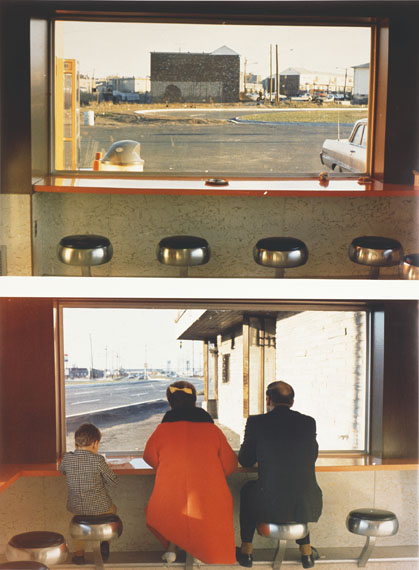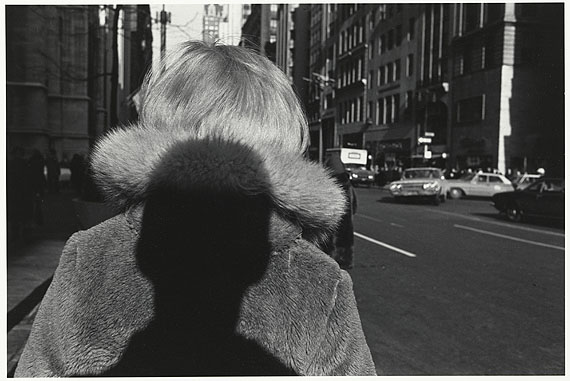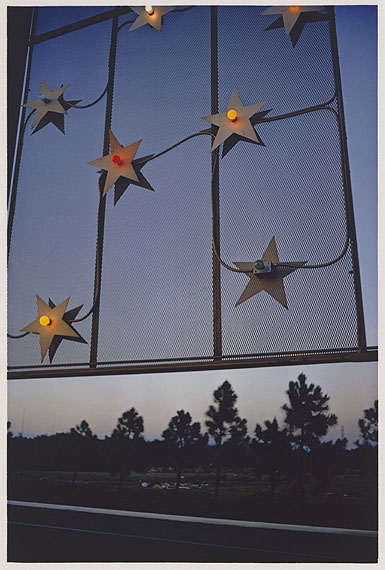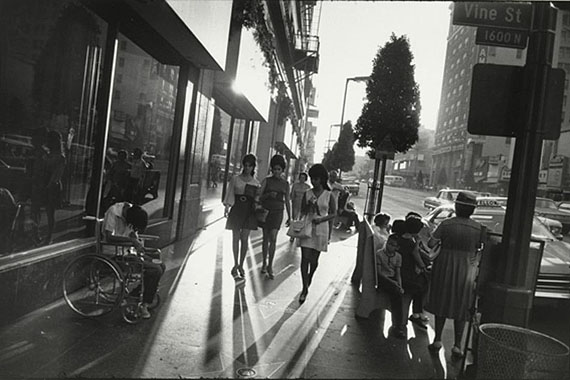
View Interior, New Highway Restaurant, Jersey City, N.J., 1967 (detail)
C-prints (printed in 1996)
each 50.6 x 76.2 cm (images)
On permanent loan from Siemens AG, Munich, to the Sammlung Moderne Kunst since 2003
© Dan Graham
true stories
Robert Adams » John Baldessari » Lewis Baltz » Larry Clark » William Eggleston » Lee Friedlander » John Gossage » Dan Graham » Zoe Leonard » Nicholas Nixon » Richard Prince » Martha Rosler » Judith Joy Ross » Ed Ruscha » Stephen Shore » Garry Winogrand »
Exhibition: 2 Mar – 30 Sep 2012
Thu 1 Mar 19:00

Pinakothek der Moderne
Barer Str. 40
80333 München
+49 (0)89-23805360
info@pinakothek.de
www.pinakothek.de
Tue-Sun 10-18, Thu 10-20

New York City, 1966
Gelatin silver print,
Baryt paper (card)
21.9 x 32.8 cm (image)
On permanent loan from Siemens AG, Munich, to the Sammlung Moderne Kunst since 2003
© Lee Friedlander
true stories
American photography from the Sammlung Moderne Kunst
Pinakothek der Moderne, Gallery 21
Opening: Thursday 01.03.2012, 7.00 p.m.
Exhibition duration: 02.03.-30.09.2012
American photography forms an extensive and simultaneously top-quality focal point in the collection, of which a selected overview is now being exhibited for the first time. The main interest of young photographers, who have been examining changes in political, social and ecological aspects of everyday American life since the late 1960s, has been the American social landscape. They have developed new pictorial styles that define stylistic devices perceived as genuinely American while at the same time being internationally recognised. Whereas Lee Friedlander, Garry Winogrand, Robert Adams, Lewis Baltz and Larry Clark, who are now considered classical modern photographers, have remained true to black-and-white photography, William Eggleston and Stephen Shore in particular have established colour photography as an artistically independent form of expression. The exhibition brings together around 130 works that, thanks to the Siemens Photography Collection and through acquisitions, bequests and donations, are now part of the museum’s holdings. true stories covers a spectrum from the street photography of the late 1960s to New Topographics and pictures by the New York photographer Zoe Leonard, taken just a few years ago.
'A new generation of photographers has directed the documentary approach toward more personal ends. Their work betrays a sympathy for the imperfection and frailties of society. Their aim has been not to reform life but to know it.' With the exhibition New Documents in spring 1967, John Szarkowski, the influential curator of photography at the Museum of Modern Art in New York, rang in a new era in American photography. Those photographers represented, including Lee Friedlander and Garry Winogrand in addition to Diane Arbus, stood for a change in attitude within documentary photography that was conditioned exclusively by the subjective viewpoint of an individual’s reality. The object of photographic interest lay in the American social landscape and its conditions. It was less concerned with the natural landscape and its increasingly cultural reshaping than with the urban or urbanised space and how people move within it. In so doing, the New Documentarians rejected any obviously explanatory impetus, turning instead to the everyday and commonplace.
The exhibition New Topographics: Photographs of a Man-Altered Landscape that was staged in the mid 1970s at the International Museum of Photography in Rochester, represented a countermovement to this subjective form of expression. Their protagonists, including Robert Adams, Lewis Baltz, Nicholas Nixon and Stephen Shore, also pleaded for a documentary approach and were influenced by figures such as Walker Evans und Robert Frank, but considered themselves rooted in the tradition of 19th-century topographical photography in particular. The prime initiator of this working method, that was expressly not governed by style, is the Los Angeles-based artist Ed Ruscha. Their central aim is a distanced and seemingly analytical depicition, free of judgement; their topic, the landscape altered by mankind. It is the image of the American West in particular, so much conditioned by myths and dreams but long since brought back to reality as a result of commercial and ecological exploitation, that is visible in their works.
The decisive quantum leap to establishing the position of colour photography was made by the Southerner William Eggleston in his exhibition in 1976, also held at the Museum of Modern Art in New York, and the publication of the William Eggleston’s Guide. The harsh public criticism of his pictures was not to do with his use of colour but the fact that Eggleston photographed things and everyday situations – on the spur of the moment and in a seemingly careless manner – that, until then, had not been considered worthy of being photographed turning them into exquisite prints using the expensive and complicated dye-transfer process. In Eggleston’s cosmos of images that is strongly influenced by motifs and the light of the Mississippi Delta, colour constitutes the picture. The “rush of colour” championed by this exhibition led to the comprehensive implementation of colour photography in the field of artistic photography in the years that followed, starting in the USA and then in Europe – and especially in Germany.
An artistic attitude became established at the end of the 1970s that, with recourse to existing picture material from art, film, advertising and the mass media, formulated new pictorial concepts and, in the same breath, opened up traditional artistic and art-historical categories such as authorship, originality, uniqueness, intellectual property and authenticity to discussion. Appropriation Art owes its decisive influences to the artist John Baldessari, who lives and teaches in California. One of its most famous representatives is Richard Prince, who became famous in particular as a result of his artistic adaptation of advertising images. Concept art in the 1960s and ’70s similarly makes use of photography, both as part of an artistic practice using the most varied of materials and as a unique medium for documenting campaigns, happenings and performances. As works by Dan Graham and Zoe Leonard clearly show, the previously precisely delineated boundaries between photography that alludes to its own intrinsically, media-related history and the use of photography as an artistic strategy, have become more fluid.
A magazine has been published to accompany the exhibition (www.cedon.de), Price: 16 €
Curator:
Dr. Inka Graeve Ingelmann
Head of the Department of Photography and New Media
true stories
Amerikanische Fotografie aus der Sammlung Moderne Kunst
Pinakothek der Moderne, Saal 21
Eröffnung: Donnerstag, 01.03.2012, 19.00 Uhr
Ausstellungslaufzeit: 02.03.-30.09.2012
Die amerikanische Fotografie bildet einen umfangreichen und zugleich hochkarätigen Sammlungsschwerpunkt, der erstmals in einem konzentrierten Überblick vorgestellt wird. Das zentrale Interesse junger Fotografen, die sich seit den späten 1960er Jahren mit den veränderten politischen, gesellschaftlichen und ökologischen Bedingungen der amerikanischen Lebensrealität auseinandersetzen, gilt der American Social Landscape. Sie entwickeln neuartige Bildformen, die als genuin amerikanisch empfundene, zugleich auch international rezipierte Stilmittel definieren. Während die schon heute zu den modernen Klassikern zählenden Fotografen Lee Friedlander, Garry Winogrand, Robert Adams, Lewis Baltz oder Larry Clark weiterhin der Schwarzweißfotografie verpflichtet bleiben, haben vor allem William Eggleston und Stephen Shore die Farbfotografie als künstlerisch eigenständige Ausdrucksform etabliert. Die Ausstellung führt rund 130 Werke zusammen, die sich sowohl dank der Siemens Fotosammlung als auch aufgrund von Erwerbungen, Stiftungen und Schenkungen in Museumsbesitz befinden. true stories spannt den weiten Bogen von der Straßenfotografie der späten 1960er Jahre über die New Topographics bis hin zu den erst vor einigen Jahren entstandenen New York Fotografien der Künstlerin Zoe Leonard.
»Es gibt eine neue Generation von Fotografen, die den dokumentarischen Ansatz ins Persönliche wenden. Ihre Arbeiten lassen eine Neigung für das Unvollkommene, Fragile der Gesellschaft erkennen. Ihnen geht es nicht darum, das Leben zu verbessern, sondern es zu kennen.« Mit der Ausstellung New Documents läutete der einflussreiche Foto-Kurator am New Yorker Museum of Modern Art, John Szarkowski, im Frühjahr 1967 eine neue Ära der amerikanischen Fotografie ein. Die vertretenen Fotografen, neben Diane Arbus Lee Friedlander und Garry Winogrand, standen für eine veränderte Haltung innerhalb der dokumentarischen Fotografie, die ausschließlich von der subjektiven Sicht auf die Wirklichkeit des einzelnen bestimmt war. Der Gegenstand des fotografischen Interesses war die American Social Landscape und ihre Bedingungen. Es ging dabei weniger um die Natur-Landschaft und deren zunehmende kulturelle Überformung, als um den urbanen oder urbanisierten Raum und das Agieren des Menschen in ihm. Dabei verweigerten sich die neuen Dokumentaristen einem offenkundigen aufklärerischen Impetus, sondern wendeten sich dem Alltäglichen und Gewöhnlichen zu.
Eine Gegenbewegung zu dieser subjektiven Ausdrucksform stellte die Ausstellung New Topographics:Photographs of a Man-Altered Landscape dar, die Mitte der 1970er Jahre vom International Museum of Photography in Rochester organisiert wurde. Ihre Protagonisten, unter ihnen Robert Adams, Lewis Baltz, Nicholas Nixon und Stephen Shore, beriefen sich zwar ebenfalls auf eine dokumentarische Haltung und Vorbilder wie Walker Evans und Robert Frank, doch sahen sie sich vor allem in der Tradition der topographischen Fotografie des 19. Jahrhunderts. Als wesentlicher Initiator dieser ausdrücklich nicht um Stil bemühten Arbeitsweise gilt der in Los Angeles ansässige Künstler Ed Ruscha. Eine distanzierte, analytisch anmutende und zugleich urteilsfreie Beschreibung ist ihr zentrales Anliegen, ihr Thema die vom Menschen veränderte Landschaft. Es ist vor allem das von Mythen und Wunschvorstellungen geprägte Bild des amerikanischen Westens, das durch Kommerzialisierung und ökologischen Raubbau schon lange von der Realität eingeholt wurde, das in ihren Werken sichtbar wird.
Der entscheidende Quantensprung auf dem Weg zur Etablierung der Farbfotografie vollzog der Südstaatler William Eggleston mit seiner 1976 ebenfalls im New Yorker Museum of Modern Art gezeigten Ausstellung sowie der Veröffentlichung des William Eggleston’s Guide. Die harsche öffentliche Kritik an seinen Bildern galt nicht dem Einsatz von Farbe, sondern dem Umstand, dass Eggleston bis dato als nicht bildwürdig erachtete Dinge und Alltagssituationen - der Blick in ein vereistes Kühlfach oder auf eine Tankstellenwerbung - aus dem Moment heraus und scheinbar nachlässig fotografierte, um sie dann mittels des kostspieligen und aufwendigen Dye-Transfer-Verfahrens in exquisite Prints zu übersetzen. In Egglestons Bilderkosmos, der stark von der Motivwelt und dem Licht des Mississippi Deltas geprägt ist, ist Farbe bildkonstituierend. Der mit dieser Ausstellung einsetzende »rush to colour« führte in den folgenden Jahren zu einer flächendeckenden Durchsetzung der Farbfotografie im Bereich der künstlerischen Fotografie, von den USA ausgehend auch in Europa und vor allem in Deutschland.
Mit Ende der 1970er Jahre etablierte sich eine künstlerische Haltung, die unter Rückgriff auf vorgefundenes Bildmaterial aus Kunst, Film, Werbung oder den Massenmedien neue Bildvorstellungen formuliert und im gleichen Atemzug tradierte künstlerische und kunsthistorische Kategorien wie Autorenschaft, Originalität, Einzigartigkeit, geistiges Eigentum und Authentizität zur Diskussion stellt. Entscheidende Einflüsse verdankt die Appropriation Art dem in Kalifornien lebenden und lehrenden Künstler John Baldessari, einer ihrer bekanntesten Vertreter ist Richard Prince, der vor allem durch seine künstlerischen Adaptionen von Werbebildern bekannt wurde. Aber auch die Konzeptkunst der 1960er und 70er Jahre bediente sich der Fotografie, sowohl als Teil einer mit unterschiedlichsten Materialien agierenden künstlerischen Praxis als auch als singuläres Medium, um Aktionen, Happenings oder Performances zu dokumentieren. Wie das Werk von Dan Graham oder Zoe Leonard deutlich macht, sind die ehemals strikten Grenzen zwischen einer Fotografie, die sich auf die eigene, medienimmanente Geschichte bezieht, und der Verwendung von Fotografie als künstlerische Strategie fließend geworden.
Begleitend erscheint ein Ausstellungsmagazin (48 Seiten, 55 Abb.) erhältlich über Cedon Museumsshop (www.cedon.de), 16 Euro
Verantwortliche Kuratorin:
Dr. Inka Graeve Ingelmann
Leiterin der Sammlung Fotografie und Neue Medien

from »Southern Suite« (10-part series), 1981
Dye transfer print
25 x 38.2 cm (image)
Sammlung Moderne Kunst
in the Pinakothek der Moderne Munich
Acquired in 2006 through PIN. Freunde der Pinakothek der Moderne e.V.
© Eggleston Artist Trust

Los Angeles, California, 1969
Gelatin silver print
(pre 1984)
21.8 x 32.8 cm (image)
On permanent loan from Siemens AG, Munich, to the Sammlung Moderne Kunst since 2003
© Estate of Garry Winogrand